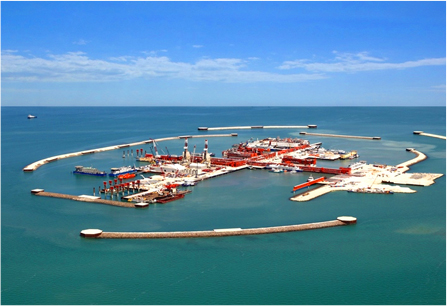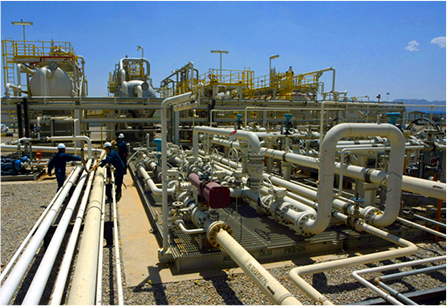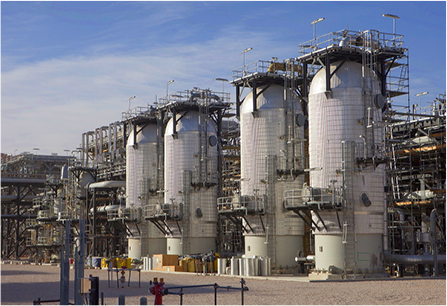Hydrogen Embrittlement
Hydrogen is often a by-product of corrosion and electrochemical processes in aqueous solutions. It may also be a major constituent of service environments. In aqueous environments, atomic hydrogen results from the donation of a proton to a hydrogen ion to form atomic hydrogen on the surface of the material.
The hydrogen atoms formed by the corrosion process may recombine to form molecular hydrogen that can accumulate and bubble off of the specimen surface. However, under certain circumstances, such as when hydrogen recombination poisons (e.g., S, P, As, Sn) are present in the environment, hydrogen recombination is retarded, which promotes the ability of atomic hydrogen to enter the material.
Once inside the material, hydrogen can affect the mechanical performance of materials in several ways: The formation of internal hydrogen blisters or blister-like cracks at internal delaminations or at sites of non-metallic inclusions in low strength materials. These internal cracks may propagate by a process called hydrogen-induced cracking (HIC) or hydrogen blistering. No external stress on test specimens is usually required to examine this type of cracking. in some cases, however, these blister cracks may take on an alignment caused by the presence of residual or applied tensile stresses. The process of hydrogen-assisted micro void coalescence can occur during plastic straining. This can reduce the ductility of normally ductile engineering materials while not inducing brittle cracking.
An extreme case of ductility loss from hydrogen is the brittle fracture of susceptible materials under applied or residual tensile stresses. This form of cracking, which typically changes from transgranular to intergranular with increasing yield strength and other processing variables, is normally referred to as hydrogen embrittlement cracking (HEC). Hydrogen embrittlement is a much studied and written about phenomena.
It is the Achilles heel of high strength ferrous steels and alloys. Hydrogen embrittlement, in the manifestation of sulfide stress cracking (SSC), is a continuing concern in the oil & gas and petroleum industries, despite years of research into cracking mechanisms, parameters and control methods. The definitive materials selection document for sour oilfield applications is NACE MR0175. Hydrogen embrittlement during manufacture of electroplated fasteners is also well documented. Less appreciated is the long-term effect of hydrogen with cracking of high strength steels and ferrous alloys under atmospheric exposure conditions.
Hydrogen embrittlement is not completely understood; however, it is generally agreed that only atomic hydrogen will enter and diffuse through a steel, in this case during corrosion. Whether absorbed, hydrogen causes cracking or not is a complex interaction of material strength, external stresses and temperature. At high strength levels (180 ksi/1241 MPa) only a few ppm of dissolved hydrogen can cause cracking.
Hydrogen Embrittlement of Stainless Steel Hydrogen diffuses along the grain boundaries and combines with the carbon, which is alloyed with the iron, to form methane gas. The methane gas is not mobile and collects in small voids along the grain boundaries where it builds up enormous pressures that initiate cracks. Hydrogen embrittlement is a primary reason that the reactor coolant is maintained at a neutral or basic pH in plants without aluminium components. If the metal is under a high tensile stress, brittle failure can occur. At normal room temperatures, the hydrogen atoms are absorbed into the metal lattice and diffused through the grains, tending to gather at inclusions or other lattice defects. If stress induces cracking under these conditions, the path is transgranular. At high temperatures, the absorbed hydrogen tends to gather in the grain boundaries and stress-induced cracking is then intergranular.
The cracking of martensitic and precipitation hardened steel alloys is believed to be a form of hydrogen stress corrosion cracking that results from the entry into the metal of a portion of the atomic hydrogen that is produced in the following corrosion reaction. Hydrogen embrittlement is not a permanent condition. If cracking does not occur and the environmental conditions are changed so that no hydrogen is generated on the surface of the metal, the hydrogen can rediffuse from the steel, so that ductility is restored.
To address the problem of hydrogen embrittlement, emphasis is placed on controlling the amount of residual hydrogen in steel, controlling the amount of hydrogen pickup in processing, developing alloys with improved resistance to hydrogen embrittlement, developing low or no embrittlement plating or coating processes, and restricting the amount of in-situ (in position) hydrogen introduced during the service life of a part.
Surface Finish Overview
The standard finish for many steel fasteners is Electroplated Zinc with a clear RoHS compliant (Trivalent) chromate passivation. This finish offers basic corrosion protection and is inexpensive. The major disadvantage of any electroplating process is that it can cause hydrogen embrittlement in fasteners with a tensile strength greater than 320 HV.
As standard, all fasteners that are case hardened and all fasteners with a property class of 8.8 or higher are heat treated after electroplating to help reduce the risk of hydrogen embrittlement. This process is called de-embrittlement but it does not guarantee that the risk of hydrogen embrittlement is removed completely. If any risk of hydrogen embrittlement is unacceptable than a non-electroplated finish should be considered.
There are many finishes available today offering various degrees of protection and cosmetic finish.




